Although the 1980s are often referred to as the decade of excess and greed, a lot of good things happened. In 1983 Sally Ride became the first American woman in space, Lech Walesa received the Nobel Peace Prize and Food Engineering named the first winner of its Food Plant of the Year competition.
Over the past two decades, plants processing pudding, poultry, produce, pasta, dairy, beef, beer, and baked goods have been honored by this Food Engineering tradition of excellence.
In honor of these award-winning plants and in celebration of FE’s 75th anniversary, we present the best and brightest in food plant design and engineering from 1983 to 2003. A synopsis of each winning plant project is presented as it first appeared in publication in Food Engineering starting with the first plant to capture the prize: Campbell’s Maxton, NC facility.
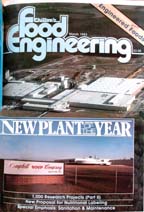
1983
Campbell Soup
Built at a cost of around $100 million and occupying 920,000-sq. ft., Campbell’s new plant in Maxton, NC, is the first new canned food plant built by Campbell in more than 15 years. It produces most of Campbell’s line of soups. With the Maxton plant, Campbell found a way to be innovative – yet conservative. As a general rule, they didn’t put anything in the new plant that hadn’t been tested in another Campbell plant.Among the many innovations at the plant is microprocessor control. This is particularly important in the blending area where microprocessors will eventually control everything. Solid ingredients such as diced carrots or potatoes will be weighed automatically into large (140 gallon), portable stainless steel vessels. When an operator with an empty vessel approaches the weigh-station to receive, let’s say, 100 pounds of carrots, the micoprocessor-controlled station will know exactly what the operator wants. It will lock the vessel into the weigh-station until the scale is satisfied that the right amount of product has been added to the vessel. Then, the system will tell the operator which blending kettle is to receive the carrots.
The filling lines in the new plant operate at speeds from 300 cans per minute to 650 cans per minute, depending upon the size of the cans. For something like Chunky soup, that speed is quite extraordinary. But even more extraordinary is the accuracy being obtained. Chunky soup in 300-gram cans, for example, is being filled at accuracies with plus/minus 2 grams.

1984
Anheuser-Busch
Architects/Engineers: H.K. Ferguson
At 8:00 a.m. on February 1, 1983, the Anheuser-Busch brewery, a 193-acre site in Baldwinsville, NY, made its first batch of Budweiser. Anheuser-Busch purchased the plant for $100 million and spent another $100 million (and three years) renovating and expanding the facility. From a start-up rate of 4.2 million barrels per year, the new brewery rapidly scaled-up production along with continuing expansion and expected to roll out 7.2 million barrels of beer per year. (One barrel of beer is equivalent to 31 gallons.)The new plant brews and packages Budweiser, Budweiser Light, Michelob and Michelob Light for a 300-mile marketing radius covering New York, Western New England, most of Pennsylvania and parts of New Jersey. Budweiser accounted for more than half of the plant’s production.
As part of the plant renovation, programmable logic control (PLC) systems replaced the majority of original relay-logic systems to control the entire brewing process including the new CIP systems. Programmable controllers also governed several functions on the plant’s new draught beer keg line.

Washington Group International, Inc. is proud to count H.K. Ferguson among its heritage companies. Since 1965, we have been designing and building new and expanded breweries for Anheuser-Busch. We have completed hundreds of beverage industry projects, including individual, grassroots breweries exceeding more than $400 million in total installed cost.
Washington Group provides the talent, innovation, and proven performance to deliver integrated engineering, construction, and management solutions for businesses and governments worldwide. With approximately 30,000 employees at work in over 40 states and more than 30 countries, the company provides premier science, engineering, construction, operations, program-management, and development services in 15 major markets.
For more information:
Ed Mihelin
Washington Group International, Inc.
500 Corporate Parkway
Birmingham, AL 35242-2928
Phone: 205-995-7166
Fax: 205-995-3808
Email: ed.mihelin@wgint.com

1985
Frito-Lay
Situated on 25 developed acres of a 283-acre site, the 112,000-sq. ft. plant—Frito-Lay’s 38th production facility—will turn out 25 to 27 million lbs. of potato chips, corn chips and tortilla chips in 1985 to serve the fast growing Southwestern market. The plant operates 24 hours a day, five to six days per week.Located in Casa Grande, AZ, the $30 million facility’s innovative plant design and engineering includes concern for the area’s environment and ecology. The plant’s architectural design, which suggests the Indian pueblo style symbolic of the region, is executed in desert earthtone colors to blend with the surrounding scene. Further, no waste streams emanate from the plant site. Everything, including wastewater, is recovered as valuable by-products or to generate co-products.
In addition, the plant’s design pulls together features from some of Frito-Lay’s other plants and combines them on a system basis. For example, the potato storage and handling system, frying lines, material handling, automated storage retrieval and programmable control—all features installed individually in other Frito-Lay plants but combined for the first time at Casa Grande.
Governed by programmable controllers
Casa Grande is also the first Frito-Lay plant totally governed by programmable controllers and the first to incorporate microprocessor control of programmable logic controllers with data feedback to the operator. Each of four stand-alone process control systems, designed by Frito-Lay engineers and built around Intel microcomputers and Gould Modicon programmable controllers, governs a specific line process: potato chip processing; corn ship processing; and tortilla-chip processing.
Microprocessors direct the programmable controllers to fine-tune the process—controlling valves, pumps, motors and conveyors for precise control of process variables such as time, temperature, speed, dwell, direction and even CIP cycles. Frito-Lay engineers designed both systems and system logic, with software help from outside consultants. All four of these systems interface with a fifth Frito-Lay designed host microcomputer which monitors and records maintenance and operational data around the clock.
All programmable controllers with their I/O (input/output) cabinets, all motor stations and most of the microprocessors are housed in a single, controlled-environment room called the “electronic control center” to further simplify maintenance. (More than 35 microprocessors are installed in the plant.) Because the plant is new, this feature could be designed-in—unlike most manufacturing plants, where PCs have been retrofitted and are located all over the place.
More control of boiler, warehouse
In addition to the four stand-alone systems and the host computer system designed by Frito-Lay, the plant features two more process control systems: A Bailey Network 90 system controls the boiler plant, a DEC system controls the AS/RS warehouse.
All process heat such as for cooking corn and heating frying oil—plus plant heat when needed—is supplied by a single gas-fired 60,000-lb. capacity Babcock & Wilcox boiler computer controlled by the Bailey system, which continuously monitors and adjusts functions such as feedwater rate, gas, oxygen, temperature, stack dampers and condensate return for optimum efficiency. Heating cooking oil via a closed-loop system saves energy costs and compared to direct gas-fired heating, offers better control of fryer temperatures.
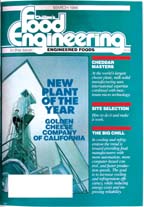
1986
Golden Cheese
Built in just 16 months, Golden Cheese Company of California’s new plant in Corona, CA, is the world’s largest cheese plant. The USDA-approved plant combines the latest proven technologies to produce 80 million lbs. of cheese, 5 million lbs. of WPC, 2.2 million lbs. of butter and 2.2 million gal. of ethanol per year. Golden Cheese chose to locate its plant in the Chino Valley, just east of Los Angeles because it is the most productive milking region in the world. Approximately 80 percent of the milking cows in Southern California are located within a 15-mile radius of the plant and that radius alone produces more milk than any of 43 states.
Plant combines British, Irish and Danish technology
The $110-million, 165,000-sq. ft. Golden Cheese plant is an international venture combining British, Irish, and Danish technology with international financing and American marketing. It operates around the clock—24 hours a day, seven days a week—producing Cheddar, Colby and Monterey Jack cheese for consumers, whey-protein concentrates of 50 to 75 percent protein for food processors, whey butter for ingredient uses and ethanol for gasohol (or “super unleaded premium gasoline with ethanol,” as the fuel is known today at the pump.)
The plant’s receiving capacity is 2.3 million lbs. of milk per day, or 40 to 50 truckloads averaging 50,000 lbs. each. The receiving station can accommodate two tankers simultaneously, pumping milk through two intake lines at a rate of 15,000-gal. per hour each and then into any of six 60,000-gal. silos, each mounted on load cells to tell the process controller how much milk is on hand in any silo at any given time.
To make cheese, the process controller selects milk from any silo and routes it through a custom-built Pasilac pasteurizer at a rate of 16,000 gal. per hour. The milk continues through a Westfalia clarifier and unique standardization/separator system which automatically adds or removes butterfat to maintain a constant 0.65 fat-to-protein ratio for optimum cheese yields. Milk then moves into one of the eleven 45,400-lb. capacity Pasilac cheese vats selected by the operator.
Meanwhile, lactic-acid starter cultures are propagated and continuously inoculated into the cheese vats by means of a Biloac external pH-control system governing five 10,000 lb. capacity propagation tanks and five 10,000-lb. holding tanks, also on load cells to continuously feed starter status to the control room. As acid levels rise during incubation, this system automatically adds ammonia hydroxide to maintain pH above 5.6.
All the variables in the cheesemaking process—time, temperature, culture dose, rennin dose, color dose, setting, cutting, cooking, agitation—are computer-controlled from either the central control room or a local microcomputer at each vat. Microcomputer memories contain up to seven different cheese formulas, which can be adjusted along with processing conditions via keyboard at the vat. Computer control allows the operator to confirm milk composition, instantly determine cheese yields and make decisions a lot faster. System capacity: 4,500 lbs. of cheese per vat, from 52 vats, four to five turnovers per vat per day.
Further, membrane filtration technology, although relatively new, is widely used today to fractionate and concentrate proteins from whey. But the whey-protein process at Golden Cheese takes the technology a step further. Lactose permeate is concentrated by reverse osmosis for use as a fermentation medium to produce alcohol. Concentrated lactose goes to fermentation; the separated mineral stream goes through another RO system to remove the minerals. Result: Pure demineralized water, recycled as diafiltration water for ultrafiltration and as CIP sanitizing and rise water. The plant recovers 35 percent of the water from the original milk.

1987
Steuben Foods
For 10 years an immense, 786,000-sq. ft. shell of a building built but never completed stood on a 162-acre site in Elma, NY. As part of the renaissance of Buffalo and Erie County, a large part of the building, 172,500-sq. ft., has been converted by Steuben Foods, Inc. into a high-tech plant combining aseptic technology, biotechnology, computerized process control and robotics to produce and distribute Whitney’s yogurt, a national brand marketed by Whitney’s Foods, Inc., a wholly-owned subsidiary of Kellogg Co.Renovation, as opposed to new construction, dramatically cut project time and costs. From start to plant start-up in April 1985, the project took only 16 months. Total investment to date [March 1987]: about $26 million—$16 million by Steuben, the rest from other sources. The project’s major improvements include: a new rubber-membrane roof; new caissons and a poured-concrete floor; a new, attached office building; overall code upgrade of the structure; and two service roads linking the site to county highways.
Unique energy and utility features
The plant features a number of unique energy and utility features including pressurized, hyperfiltered HEPA air systems in packaging and culture rooms which filter out airborne microorganisms as miniscule as 0.3 microns. This contributes to extended product shelf life. The filters are the same as those installed in hospital operating rooms. Except for the refrigerated warehouse, the entire plant is pressurized in graduated stages outward from packaging and culture rooms toward outside walls to minimize airborne contamination.
Other utility features include double-walled HVAC systems with encapsulated insulation, designed for easier cleaning and sanitation. A large dry-storage area allows plenty of room for future plant expansion.
Process control is key feature
Two process control features basically control the plant: a Gould Modicon system, operated by only one man, governs all operations from receiving through filling, while a DEC system controls material-handling operations from palletizing to refrigerated warehouse. Secondary packaging operations (capping and cartoning) are governed by local programmable controllers.
The process control system is based on a Modicon 584 programmable controller (the CPU) with associated input-output devices. Operator-interface to the CPU is via Integrated Graphics Processor (IGP) connected to two Modivue touch-screen CRT terminals. A Modicon P-190 system with CRT and keyboard is used for diagnostics and local programming. The Modicon-based system controls process variables such as times, temperatures and flow rates, operations such as batching, blending, culture inoculation, tank inventories and CIP cycles, displays alarms and interfaces with a printer for hard-copy reports. Touch-screen control is innovative technology which replaces conventional “hardwire” devices such as rotary switches, push buttons, thumbwheels and digital readouts.
The DEC system controls robotic “smart carts,” assigns warehouse pallet addresses for later recall to fill orders and interfaces with a unique Micromatic/Microcrane order-pick system to assemble mixed pallet loads of varying flavors according to customer order. Both the Gould and the DEC systems interface via phone modem to an IBM MIS system. Customer orders are received from Whitney’s via modem by an IBM 36 and transmitted by keyboard to the DEC system for filling.

1988
Coors Shenandoah Brewery
On April 14, 1987 Adolph Coors Co.—the 115-year-old Colorado brewer—started up its Shenandoah Brewery at Elkton, VA, on a magnificent 2,700-acre site bordered by the Blue Ridge Mountains to the east and the south fork of the Shenandoah River to the west. The new plant stretches Coors production from the Rockies to the Alleghenies and is considered a major step in the company’s goal to becoming a national brewer.Coors Shenandoah Brewery doesn’t have a brewhouse yet. Beer is currently shipped by rail in insulated tank cars (to maintain fresh draft taste) from the company’s huge plant at Golden, CO (world’s largest single-site brewery), then blended with water, finished and packaged at Elkton. The plant is being built in stages, with actual brewing operations yet to come. Phased construction allows flexibility to add brewing when needed to the finishing/packaging operations that are in place.
$170 million investment
But in terms of capital cost, Coors Shenandoah Brewery at $100 million initial investment nevertheless ranked second in food/beverage industry new plant startups last year [1987], and with completion of Phase II in July 1988, the new plant will represent an investment of $170 million.
Current capacity: 2.5 million barrels of Coors and Coors Light per year, finished and packaged in three major buildings completed to date and distributed to as many as 14 Eastern states. Current operations occupy only about 200 acres of the extensive site and employ 220 people. When completed, the plant will roll out 10 million barrels per year to cover everything East of the Mississippi.
Buildings are laid out campus-style to complement the environment and allow plenty of room for the phased expansion without disrupting ongoing production. Major structural features include: pre-cast, pre-insulated tilt-up wall panels of earth-tone concrete aggregate which sped construction, blend with the surroundings and are easily removed to allow building expansion and equipment access; open bays with relatively few structural columns to ease equipment access; and a refrigerated warehouse, maintained at 38˚F to assure the draft flavor and quality of Coors beers, and equipped with airlocks to prevent refrigeration loss when loading trucks. Phase II of construction at Shenandoah will include the expansion of blending, finishing, packaging and waste-treatment operations.
A Bailey Network 90 system monitors boiler operations, air compressors and electrical demand/distribution while controlling refrigeration compressors from a central console in the plant’s utilities building. Three propane or gas-fired Cleaver-Brooks watertube boilers each generating up to 15,000 lbs./hr. steam pressure supply hot water and steam for CIP and sterilizing operations. Feedwater is deionized to prevent scale. Three 800-hp Frick ammonia screw compressors, capable of 650 tons refrigeration each, incorporate microprocessors for local-control options.
Wastewater flows to the plant’s own waste-treatment facility, being expanded with each construction phase to match expanding production capacity. Essentially an aerobic process, the system reduces BOD (biological oxygen demand) in plant wastewater from a current average of 34,000 lbs. per day to about 30 lbs. per day and TSS (total suspended solids) from 204 mg/1 to 25 mg/1 before discharge into the Shenandoah River. Both standards are well under state regulatory limits. Basic process: Aeration, re-aeration, clarification, chlorination, dechlorination and sludge removal. Sludge is hauled off-site to other waste-water treatment plants. An aerobic digestor, under study, allows the plant to treat its own sludge.
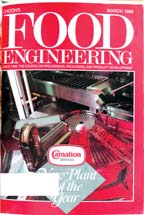
1989
Carnation Co.
Carnation Co. started up its new $80 million, 225,000-sq. ft. ice cream and frozen novelty plant on a 30-acre site in Bakersfield, CA, about 100 miles north of Los Angeles at the southern end of the fertile San Joaquin Valley. As the world’s largest ice cream plant, the facility produces more than 35 million gallons of ice cream and frozen novelties per year.The plant turns out a vast range of stick and stickless novelties including ice cream and ice-milk bars, cups, cones, push-ups, sandwiches and fruit-flavored water ices, plus packaged and bulk ice cream ranging from premium to low-fat varieties. Considering every product variety and packaging size, the new plant is producing hundreds of different items on many flexible production lines.
Straightforward product flow
The new plant is designed for straightforward product flow, continuous operation, production flexibility, tight sanitation, easy expansion and to withstand the geological proclivities of California. Its major structural features include: structural steel frame mounting 20 x 35-ft. exterior concrete tilt-up wall panels, cast on site and able to be moved to allow modular expansion; seismic zone 4 construction standards; interstitial space between plant ceiling and roof creating a “walk-on” ceiling supported by roof trusses to house electrical cables and HVAC ducts and allowing access to lighting fixtures from above; clear, column-free, 44,000-sq. ft. main production room; and acid-brick floors to resist corrosion by sanitizing solutions.
Vast product range
Producing a vast range of ice cream and frozen novelty products requires a vast range of ingredients: both fluid and dry dairy ingredients such as condensed whole milk, buttermilk, skin milk, cream, butter and whey; sweeteners such as sucrose, corn syrups and high-fructose corn syrups (HFCS); coatings such as chocolate and cocoa powders; flavorings such as extracts, fruits and fruit purees; stabilizers and emulsifiers; topping and texture ingredients such as nuts, candies and marshmallows; cookies for sandwiches and cones for Drumsticks. The plant will use 400,000 lbs. of strawberries and 600,000 lbs. of cookies and candies annually.
Fluid dairy ingredients are typically received in 3,000-gal. or 6,000-gal. tank trucks which are checkweighed on a Toledo truck scale and proceed to a receiving island for sampling and QC analysis before offloading. The receiving island features twin stations, each equipped for unloading and cleaning tank trucks: While one truck is connected to the receiving pumps, another can be simultaneously cleaned in place. A raw fluid dairy ingredient moves from the receiving island via Tri-Clover centrifugal pumps for cooling through an APV plate heat exchanger and is routed through a cluster of computer-controlled pneumatic valves into one of eight (three 6,000-gal., five 10,000-gal.) Mueller stainless-steel storage tanks flanking each side of a raw-ingredient tank corridor extending from the plant building. This design isolates non-pasteurized product from the rest of the plant. A ninth, 20,000-gal. tank at one end of the tank corridor stores liquid sucrose. The corridor also houses two three-tank Hartel CIP systems for cleaning the “raw side” of the plant, including truck CIP at the receiving island.
Dry ingredients, typically received in palletized bags, are offloaded via fork lift at five receiving docks, recorded and assigned specific pallet locations via computer terminal and stored in bays in the 37,000-sq. ft. dry-storage room, which also houses packaging materials.
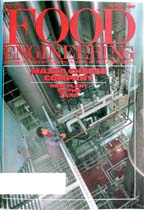
1990
Mazza Cheese
Company
Design/Builder:
Shambaugh & Son, L.P.
The $27-million, 95,000-sq. ft. Mazza Cheese plant located in Sumner, WA, opened in April 1989. Designed to process 1.2 million lbs. of milk and 1 million lbs. of whey per day, the plant produces part-skim and whole-milk mozzarella in loaf, diced and shredded varieties primarily for pizza parlors; vacuum-packed mozzarella balls in 8-, 12- and 16-oz. sizes; feta for retailers and Greek restaurants; provolone to special order; and whey powder and whey cream as food ingredients.
The plant, which operates continuously 24 hours per day, seven days a week, was the first in the state of Washington to meet new discharge standards three times more stringent than previous regulations. Mazza’s wastewater-treatment plant is a $2.5 million, low-rate activated sludge system designed to handle wastewater loads of up to 500,000 gal. per day (500 gal. per minute at peak hours) and BOD loads up to 5,000 lbs. per day.

Whether you are a valued repeat customer, or a prospective client, considering a $50,000 or $50,000,000 budget, planning a retrofit or a new facility, we urge you to visit with us to learn how Shambaugh & Son may be the “right fit” for you and your company. With our continued growth and nationally recognized award winning projects, we may be the “right fit” for you now more than ever. We offer your project team success through world-class innovation, single source responsibility, lower “total” costs, fast track schedules and a performance proven record second to none.
Allow us to discuss our “Value Added” Services with you
• Process Improvement/Optimization
• Process and Facility Simulation/Modeling
• Process Control Integration/Automation
The only three-time U.S. food plant of the year winner.
For more information:
Shambaugh & Son, L.P.
POB 1287
Fort Wayne, IN 46801
260-487-7807
www.shambaugh.com

1991
General Mills
Architects/Engineers:
Lockwood Greene
Situated on a 100-acre site in Covington, GA, General Mills’ seventh and newest plant operates continuously around the clock, 365 days per year with four self-managing teams of about 25 technicians each alternating in 12-hour shifts to turn out ready-to-eat “Big G” breakfast cereals. The plant consists of three major structures: a 24,000-sq. ft. employee facility housing administrative and team-support functions, and linked to the process building by a glass-enclosed pedestrian bridge; the 400,000-sq. ft. process building enclosing an additional 19,000-sq. ft. shipping area; and a 15,000-sq. ft. utility building with steam, water, air and electricity across a utilities bridge.
Designed as a “make-and-ship” plant to supply three General Mills distribution centers across the South, the site needs no warehousing facilities. The process building is equipped with parallel puff and flake systems to produce a variety of Big G cereals. Started in April 1990, the $100-million-plus plant marks the first phase of a three-year, $550-million expansion program (part of an overall $1.65 billion corporate capital investment plan).

Lockwood Greene is a global business partner for engineering and construction serving food & beverage clients throughout the U.S. and internationally. Founded in 1832, the company employs 2,500 professionals in 30 offices worldwide with a complete complement of resources to enable a successful project launch. We provide the full range of traditional engineering and construction disciplines for planning, processing, packaging, warehousing and distribution. Lockwood Greene's Food & Beverage Team minimizes the time it takes to get your capital project fully operational with testing, training, validation and start-up services to maximize your efficiency and help you seize that critical product-to-market window.
For more information:
Burt Young
11311 Cornell Park Drive
Suite 500
Cincinnati, OH 45242
Phone: 513-587-7030
Fax: 513-530-5541
byoung@lg.com
www.lg.com

1992
Pepperidge Farm
Architects/Engineers: Day & Zimmermann
Billed as the largest U.S. food plant that became operational in 1991, Pepperidge Farm’s new 661,000-sq. ft. facility in Denver, PA, consists of three main areas: bakery side, 260,000-sq. ft.; biscuit side, 321,000-sq. ft.; office area, 30,000-sq. ft. From the first shovel of dirt on October 23, 1989, to the completion of the facility just 21 months later, an amazing 700,000 cubic yards of dirt were moved during construction.Pepperidge Farm had one prime criterion for the design of the Denver facility: sanitation. The entire structure is made from precast, prestressed concrete. Precast concrete is poured off-site and pre-erected, which, in addition to making the design more sanitary, speeds the overall construction time of a facility.
Part of the hyperplant’s unique design is the spectacular one-quarter-mile gallery/hallway that separates the bakery and biscuit areas. Twelve feet above the production floor, this area serves three main purposes. It serves as a visitor gallery and walkway for personnel affording an excellent view of production areas. Above the walkway, it houses the utilities for the plant—gas, water, insect fogging systems, a central cleaning system and the plant’s fiber optic network. At the production level, the hallway is the path for all forklift traffic. Floors in the primary processing areas are covered with acid resistant brick.
All major equipment in the facility is PLC controlled and linked through a fiber optic network to the control room. Running through the entire facility, this network allows communication between the control room and production floor and between the host computer and business functions.

For more than 100 years, Day & Zimmermann has been helping businesses be more successful at what they do. And along the way we’ve built a comprehensive portfolio of high-quality services in the food and beverage industry: Engineering, Procurement, Construction, Validation, Maintenance, Program management, and Strategic alliances.
All delivered safely, soup to nuts. With top engineers and team managers on each project, backed with the latest industry technology, providing effective and efficient solutions.
At Day & Zimmermann, We do what we say.® — and that’s more than just a slogan. It’s our promise.
For more information:
Tex Carter, Vice President,
Account Management and Sales
125 The Parkway
Greenville, SC 29615
phone: 864.241.6884
fax: 864.241.6750
www.dayzim.com

1993
Carolina Food Processors
Design/Builders: The Stellar Group
In October 1992, Smithfield Foods started up the world’s largest hog processing plant, the $77 million Carolina Food Processors plant in Tar Heel, NC. Designed to kill and cut up to 32,000 hogs per day, the new plant supplies Smithfield and Gwaltney plants in Virginia and North Carolina with primal cuts for further processing into consumer products. Including the 100,000-sq. ft. stockyards and staging area, a rendering facility, a utility building and office space, the complex spans more than 530,000-sq. ft. on a 168-acre site, which also incorporates a 74-acre wastewater treatment plant. Current throughput is about 14,000 hogs a day, processed by 985 employees operating two highly automated disassembly lines on one eight-hour production shift.
Preliminary planning for the facility spanned more than two years and the plant design incorporates a high degree of European technology. The entire complex was constructed as a fast-track project in just 13 months. Structural features include pre-cast concrete double-tees and columns, site-cast concrete tilt-up panels on non-refrigerated wall areas and pre-insulated metal panels coated with stainless steel or Kynar for easy washdown on refrigerated areas.

The Stellar Group provides complete design, engineering, construction and mechanical services, and is recognized as a leader developing projects for perishable related food processing and distribution facilities. As a specialty, Stellar offers comprehensive mechanical services including industrial refrigeration, thermal insulation for walls, floors and roofing, mechanical fabrication, installation, commissioning, maintenance and repair. Stellar has provided business planning/real estate facility solutions to some of the biggest corporations worldwide. In addition to its Jacksonville, Florida headquarters, Stellar maintains more than 20 strategic locations throughout the United States, and serves South and Central America with business units in Mexico, Brazil and Puerto Rico.
For more information:
Ernie Veale, Senior Vice President
The Stellar Group
2900 Hartley Road
Jacksonville, FL 32257
904-260-2900 / 800-488-2900
904-268-4932 fax
stellar@thestellargroup.com
www.thestellargroup.com

1994
Jerome Cheese
Jerome Cheese Co., a new $36-million, 140,000-sq. ft. cheese and whey-products plant started up in January 1993 on an 18-acre site at Jerome, in Idaho’s milk-producing Magic Valley near the rim of the scenic Snake River Canyon. The plant has capacity to process up to 3.2 million pounds of milk per day into nine varieties of barrel cheese plus dry sweet whey, sweet cream and whey cream. The plant is designed for expansion into specialty whey and lactose products.
High degree of automation
The new Jerome Cheese plant’s design incorporates a high degree of automation to manufacture consistently high-quality products; minimize the number of employees to operate the plant; reduce the manual labor required, boosting employee safety and minimizing potential for injuries; and minimize energy costs and maintenance. The system allows operators to make real-time adjustments for consistent control of product quality. In addition, a building-management system monitors and controls utilities such as steam, water, compressed air, waste water pretreatment and ammonia-refrigeration systems, and interfaces with the data-acquisition systems.
The receiving area is equipped to unload four tankers simultaneously. Each bay is equipped with a hydraulic catwalk and an overhead sprayball for tanker CIP. Further, milk is unloaded at a rate of 3,000 lbs. per minute at each of the tanker stations, making total receiving capacity 12,000 lbs. per minute. And, each load of milk is sampled both manually and by an automated in-line sampling system for analysis in an adjacent lab before acceptance.
High degree of sanitation
The high degree of sanitation built into the plant minimizes product contamination and reduces maintenance. All 14 silos are clad in stainless steel to eliminate routine painting. Doors, drains, window frames, brackets, pipes, conduit, and air-duct liners are made of stainless steel. Acid-resistant dairy-brick floors extend throughout the plant, even to the milk receiving stalls where tankers unload. Each of the four receiving bays is equipped for tanker CIP. Process areas feature ceramic-tile walls up to six feet high, with a fiberglass coating sprayed on above that.
Four major heating and ventilating systems deliver 130,000 cfm of 95 percent filtered air, changed 15 to 20 times per hour and pressurized by controlling the amount exiting the plant. Air thus flows outward from process areas to minimize airborne contaminants.
The process incorporates eight independent Scherping CIP systems. Each major stage in the process—such as raw-milk receiving, culture production, make vats, drain tables and waste water treatment—has its own CIP capabilities.
Construction challenges on the project included the need to blast out 13,000 cubic feet of bedrock, partly to lay a rail spur; rerouting an existing irrigation canal around the plant and underground to avoid insect-breeding standing water; earthquake resistance, requiring (for example) that concrete footings for the plant’s 14 silos be up to four times wider than conventional footings.
In this era of downsizing and restricted capital spending, many large food companies focus on short-term profits. Jerome Cheese, however, reflects the long-term focus of Davisco International. The plant is not only designed for expansion but integrates process control with the corporate MIS system to a degree that even allows remote control of the plant.
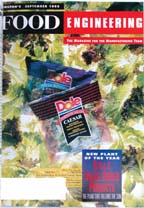
1995
Dole Value Added Products
The new $28 million Dole Value Added Products Plant at Soledad, CA, leapfrogs conventional plant design and sets a new standard in the fresh vegetable industry. The plant’s design innovations include: USDA-equivalent sanitary standards, applied for the first time to the largely unregulated fresh-vegetable industry; Hazard Analysis Critical Control Points (HACCP); process innovations, including a new and redesigned equipment plus technology transfer from other food-processing industries; and improved mobility, allowing more efficient seasonal relocation of more equipment.The plant is designed to convert 360 million pounds of raw vegetables into 190 million pounds of finished products per year. Dole salads and pre-cut vegetables offer 100-percent usable product to the consumer, so more than 40 percent of raw-vegetable weight—about 400,000 pounds per day—is removed as waste.
About 900 mostly seasonal employees working three shifts (two production, one cleanup) process some 25 different vegetables into 70 “active” SKUs. Vegetables are typically harvested, transported, processed, packaged and shipped within 36 hours. No raw materials are inventoried; once in-plant, vegetables can move from bin to bag in 12 to 15 minutes. About 50 percent of all production is made to order; no finished goods are warehoused on-site. Most orders are shipped the same day the customer’s order is placed.
Ships 60,000-80,000 cases per day
The plant typically ships about 60,000 cases of finished products per day but has shipped as many as 80,000. Finished products are shipped about 40 miles to a former plant in Marina, now a distribution center.
Vegetables are received in palletized harvest bins weighing 600 to 900 lbs. each, 20 bins per flatbed trailer. After weigh-in and physical inspection, vegetables are cooled to 35-40˚F in a conveyorized vacuum cooler or hydroshower to remove field heat. Huge forklifts designed to handle 20 bins at a time (10 pallets stacked two high) move entire flatbed loads from trucks to cooler, then after cooling into the raw-material warehouse, where smaller forklifts continuously supply trim-line hoppers with two bins at a time. This rapid-handling system minimizes outside staging time for cooled product. Redesigned bin dumpers roll rather than drop product into hoppers, reducing product damage and extending shelf life.
Vegetables are conveyed down trim lines for visual inspection, manual trim, and removal of defects and field debris. Trim lines are of 30-ft. modular stainless steel construction for improved sanitation and minimum breakdown during plant relocation. Power supply is electric rather than hydraulic to further ease reinstallation. Trim-line waste is removed at rates up to 120,000 lbs. per hour via Reyco pneumatic conveyors (rather than typical belt conveyors) and blown directly to the waste press for composting. The pneumatic system better handles wet, leafy waste, minimizes capital costs and is easily cleaned with a chlorine/water purge.
Quality assurance incorporates HACCP, with three shift supervisors and 22 technicians monitoring critical control points such as water temperatures, chlorine levels, plant temperatures, and metal detectors. The plant’s QA lab inspects incoming raw materials, and samples finished products for specifications such as cut, size, package weight, shelf life, and mix ratio. QA technicians and product teams apply SPC to tightening package fill-weight variances. Microbiological testing is conducted by an independent lab, and plant technicians use 3M Petrifilms for quick quantitative indications of bacterial growth on equipment surfaces.

1996
Nabisco Specialty Products
Architects/Engineers: Raytheon
Monday, December 18, 1995, was start-up date for production of A.1. Steak Sauce at the new Nabisco Specialty Products Co. plant in Cambridge, MD. Start-up had been achieved in just four-and-a-half months from the initial engineering meeting on July 28, and just four months from purchase of an existing building on August 18. The project included: dismantling and completely renovating a 34-year-old building, the former Chun King plant; concurrently dismantling, transporting coast-to-coast and reinstalling equipment from Nabisco’s former plant at Oxnard, CA; upgrading and reengineering existing processes to improve production efficiency and fit the shell of the Cambridge building, which was smaller than the California plant; recruiting, hiring and training a new work force of more than 100 people; and phasing in production of four basic product lines totaling 68 SKUs.The new plant was smaller than the California plant but required increased production rates. This required renovating the building as well as reconfiguring processes. As such, loading docks were demolished and rebuilt, a new rail siding was installed, and piping was designed for improved manufacturing flexibility and to supply both current and future needs.

Washington Group International, Inc. is proud to count H.K. Ferguson among its heritage companies. Since 1965, we have been designing and building new and expanded breweries for Anheuser-Busch. We have completed hundreds of beverage industry projects, including individual, grassroots breweries exceeding more than $400 million in total installed cost.
Washington Group provides the talent, innovation, and proven performance to deliver integrated engineering, construction, and management solutions for businesses and governments worldwide. With approximately 30,000 employees at work in over 40 states and more than 30 countries, the company provides premier science, engineering, construction, operations, program-management, and development services in 15 major markets.
For more information:
Ed Mihelin
Washington Group International, Inc.
500 Corporate Parkway
Birmingham, AL 35242-2928
Phone: 205-995-7166
Fax: 205-995-3808
Email: ed.mihelin@wgint.com

1997
Hudson Foods
Kentucky Division
The Kentucky Division of Hudson Foods’ gleaming new $95 million greenfield poultry plant in Robards, KY, boosts the company’s overall broiler capacity to 6.8 million birds per week. The 288-acre site includes a 320,000-sq. ft. broiler-processing plant, an 83,000-sq. ft. protein conversion plant, and support buildings for maintaining vehicles, generating energy, holding live birds, and laboratory analysis.Designed with expansion in mind, the processing plant has capacity to kill and process up to 1.3 million birds per week with space available for eventual expansion to 2 million birds per week. The plant is also designed for expansion into par-cooked and ready-to-eat products. Currently, the plant is slaughtering about 450,000 chickens per week and further processing 1.3 million per week, including carcasses supplied by other processors.
Major process-plant structural and sanitation features include: totally precast concrete interiors in the front end to resist aggressive washdowns where slaughter, scalding and picking operations occur; a galvanized tubular steel frame with walkable ceiling of smooth insulated panels; vertical utility drops from the walkable ceilings into process areas; interior walls of glazed white ceramic block 12-ft. high, with insulated metal panels above and curbs at floor level to prevent damage from pallet jacks and dollies; slip-resistant concrete floors in wet areas, sloped 1/4-inch per foot toward a total 7,000 linear feet of grated stainless steel drainage trenches ranging in depth from 8 to 42 inches; and separate drainage systems in raw-product areas and potential future cooked-product areas, to minimize possible cross contamination.
Like all large poultry plants, the new Hudson plant must implement the HACCP (Hazard Analysis and Critical Control Points) provisions of the MegaReg by January ’98. The plant implemented the Standard Operating Procedures (SOPs) required by MegaReg in January of this year [1997] and expects to have HACCP in place by July 1. Critical control points (CCPs) will include areas such as equipment services; chlorine rinse; chill temperature of birds, chill-water quality (for zero tolerance of fecal matter, as required by USDA effective March 5th); final wash between evisceration and chill; and product temperature (40˚F or lower) throughout the cutting process. Both production and quality control (QC) people will monitor CCPs with equipment such as thermometers, chlorine-test kits and Lumac kits—one-step, two-minute swap tests that detect organic presence by measuring the bioluminescence of adenosine triphophate (ATP). Corporate-trained HACCP coordinators are training production people in HACCP procedures and the QC staff will audit the program.
The QC staff measures both process and product standards on-line, including the accuracy and efficiency of equipment as well as the quality of finished products and product in-work. Examples: size, breakage, temperature, miscuts, bone and cartilage content and marination levels. Chemistry lab tests include fat, protein, moisture and ash analysis of mechanically deboned meat, feed samples and finished protein products as well as wastewater analysis (except for BOD, analyzed at an independent lab). The microbiology lab tests for E-coli as required by the Mega Reg, as well as Salmonella and aerobic bacteria in various plant areas.
Hudson’s protein plant emits very little odor. Negative pressure keeps odors in. An odor-abatement system incorporates packed-beds scrubbers and a venturi condenser that converts gases to liquid, which is added to wastewater. Wastewater pretreatment consists of two dissolved air flotation (DAF) units. Recovered cooking vapors heat water for the processing plant’s hot water requirements. DAF skimmings as well as solids recovered from pressing and screening are recycled to the feed-grade process.
A single operator controls protein-plant operations from a central console using Stord Innovation software to govern PLCs throughout the plant. The flexible system allows the operator to route product from any raw line to any cook system to any grinding system to any silo.

1998
Wyandot
Design/Builder:
Shambaugh & Son, L.P.
When a fire destroyed Wyandot Inc.’s processing plant in Marion, OH, the company lost 65 percent of its total manufacturing capacity. In July 1997—just seven months after the fire—Wyandot started-up the first four lines of a new $21 million 60,000-sq. ft. high-tech plant and reached full production capacity within one year. By using a design/build method (as opposed to a design/bid/build), the company saved four to six months and more than $5 million in downtime and loss exposure for Wyandot and its insurer.In spite of the fast-track schedule, new and unique technologies were incorporated throughout plant design. Among them, a single mill on each of the two tortilla chip lines feeds two sheeters, stabilizing masa moisture to both sheeters, which feed a common fryer. Laser-controlled variable-speed drives linked to the masa feed pumps improve feed control. PLCs automatically sequence cooking and soaking operations to optimize moisture content and continuously supply the mills.

Whether you are a valued repeat customer, or a prospective client, considering a $50,000 or $50,000,000 budget, planning a retrofit or a new facility, we urge you to visit with us to learn how Shambaugh & Son may be the “right fit” for you and your company. With our continued growth and nationally recognized award winning projects, we may be the “right fit” for you now more than ever. We offer your project team success through world-class innovation, single source responsibility, lower “total” costs, fast track schedules and a performance proven record second to none.
Allow us to discuss our “Value Added” Services with you
• Process Improvement/Optimization
• Process and Facility Simulation/Modeling
• Process Control Integration/Automation
The only three-time U.S. food plant of the year winner.
For more information:
Shambaugh & Son, L.P.
POB 1287
Fort Wayne, IN 46801
260-487-7807
www.shambaugh.com
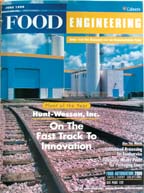
1999
Hunt-Wesson, Inc.
Architects/Engineers:
Lockwood Greene
Hunt-Wesson started up its new $54 million, 216,000-sq. ft. facility on a 43-acre site at Waterloo, IA in August 1998. The new plant has initial capacity to produce nine million cases of pudding per year and is designed to quickly expand that capacity when needed. Plant layout allows independent expansion by area—in receiving, processing, packaging, warehousing, utilities and offices—without disrupting production. The 103,000-sq. ft. warehouse, for example, can be quickly doubled in size. Utilities are in place to support additional production lines and the plant could eventually expand to 500,000-sq. ft.Dedicated to around the clock high-volume pudding production, the plant currently produces seven (of 17) Snack Pack SKUs, all single flavor puddings packaged in four 3 1/2-oz. plastic cups per sleeve. The plant employs 79 people and operates 24 hours per day, with four production teams each working three 12-hour shifts per week scheduled three days on/three off.

Lockwood Greene is a global business partner for engineering and construction serving food & beverage clients throughout the U.S. and internationally. Founded in 1832, the company employs 2,500 professionals in 30 offices worldwide with a complete complement of resources to enable a successful project launch. We provide the full range of traditional engineering and construction disciplines for planning, processing, packaging, warehousing and distribution. Lockwood Greene's Food & Beverage Team minimizes the time it takes to get your capital project fully operational with testing, training, validation and start-up services to maximize your efficiency and help you seize that critical product-to-market window.
For more information:
Burt Young
11311 Cornell Park Drive
Suite 500
Cincinnati, OH 45242
Phone: 513-587-7030
Fax: 513-530-5541
byoung@lg.com
www.lg.com
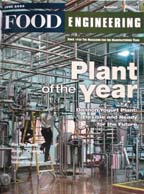
2000
The Dannon Co.
Architects/Engineers:
Case Lowe & Hart/Seiberling/Big-D
When Dannon Co.’s gleaming new 150,000-sq. ft. plant at West Jordan, UT—a southern suburb of Salt Lake City—reaches design capacity of more than 100,000 gallons per day, that won’t be the limit. Designed with expansion in mind, the plant can “unfold” in any direction on its 30-acre site. Removable insulated metal wall panels on the building’s steel frame allow expansion of all production and warehouse areas while respecting the flow path.
By June 1, 2000, the plant was operating around the clock on three shifts totaling 70 people with plans to add up to 30 more by year-end. Plant cost to date [June 2000] is about $35 million as equipment installation continues. The spacious plant is designed to accommodate six filling lines, which can be easily expanded. Annual yogurt production at the West Jordan plant is expected to reach 150 to 200 million lbs. within two years.
(continued)

Celebrating its fortieth anniversary this year, Case, Lowe & Hart of Ogden, UT, is a multidisciplinary firm with in-house architects, mechanical and electrical engineers. The firm has had extensive experience working for public clients at all levels, as well as in major commercial and industrial projects for private clients, particularly for the food processing and nutritional supplement industries. A hallmark of Case, Lowe & Hart’s industrial design philosophy is to allow the design of a building to be guided by the process flow and equipment layout, rather than requiring the process to fit into a pre-conceived building envelope.
For more information:
Case, Lowe & Hart, Inc.
Kevin J. Lewis, P.E.
President
2404 Washington Blvd, Suite 800
Ogden, UT 84401-2390
801-399-5821
fax: 801-399-0728
www.clhae.com

After exploring several prospective locations in Arizona and Utah, Dannon selected the West Jordan site because of its proximity to milk supplies in northern Utah and southern Idaho; the historically strong work ethic of people in the Salt Lake Valley; interstate highway access to California; available utilities; and good educational resources, including Brigham Young University and Utah State.
The building’s design includes large windows that admit natural light into the production and filling areas while offering spectacular views of the Wasatch Front mountains. Interior open-air courtyards in which employees can enjoy lunch and work breaks add a campus setting within the building.
(continued)

As Processing Engineering Consultants to the Dairy and Food Industries, we are dedicated to the design of sanitary process/CIP systems that will produce the highest quality product at the lowest per unit cost. We develop detail drawings, precise specifications and material lists that help you obtain competitive bids and select the best available equipment.
Our engineering and design services include:
• Process/CIP/SIP
• Control System
Integration
Want to improve your odds in today’s fiercely competitive markets? Call us today at any of our four offices shown below...we’re ready to discuss your process engineering needs.
Visit us at our web site: www.seiberling.com
For more information:
94 N. High Street
Dublin, OH 43017
614-764-2817
Eastern Office
John Miller
Guildford, Surrey GU3 3PS – England
Phone: 44 1483 237628
Fax: 44 1483 237798
European Office
Ronald Douglas

Teams are organized according to production line and areas of responsibility. Each yogurt shift is organized into nine-person line teams, with each team composed of one member in receiving, one in the QA lab, one for maintenance, four in packaging and one in the warehouse. A supervisor or “coach” is assigned to the teams to facilitate their work. Each line team meets in a team room before its shift to set daily goals for quality, safety and efficiency.

Big-D Construction was founded in 1967. For nearly four decades, they have sculpted and refined their expertise in building world-class food and dairy, distribution and manufacturing plants. Big-D Construction has offices in Salt Lake City, UT; Ogden, UT; and Jackson, WY. Extensive experience working in diverse geographical settings provide for jurisdiction understanding and first-hand knowledge of site-specific materials, costs, methodologies, vendors and subcontractors.
Extensive experience working with facility-specific materials enable Big-D employees to make knowledgeable and creative decisions, designed to improve the overall quality of each project, while enhancing the pragmatic aspects.
For more information:
Forrest D. McNabb, CPE
Sr. V.P. Dairy & Food Group
Big-D Construction
801-415-6030
www.big-d.com
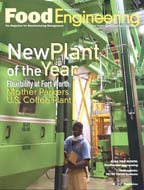
2001
Mother Parkers Tea & Coffee USA, Ltd.
Architects/Engineers:
The Austin Company
To keep pace with its growing U.S. markets, Mother Parkers Tea & Coffee acquired a coffee-roasting plant from Tetley Tea Co. at Palisades Park, NJ, and then in June 2000 started up a $25-million, 100,000-sq. ft. greenfield plant at Fort Worth, TX. The highly-automated new plant had the initial capacity to grind, blend and package private-label coffees at a rate of 20 million lbs. per year, expandable in two stages to 80 million lbs. per year, and currently manufactures more than 600 SKUs.Design supports an efficient production flow from green-bean receiving through cleaning, blending, roasting, grinding, packaging, warehousing and shipping. Totally enclosed pneumatic and vacuum handling, silo and bin systems incorporate a complicated series of PLC-controlled rotary pipe distributors, air locks, diverters, slide gates and weigh scales to move beans, ground coffee and blends from receiving through packaging.
The facility was operational only nine months after initial construction began despite heavy rain storms, an aggressive schedule and several construction challenges.

The Austin Company Food & Beverage Group is an in-house team specializing in planning, designing and implementing safe, efficient and economical food and beverage facilities. From new construction to renovations and expansions, we offer a dedicated team focused exclusively on the food and beverage industry. Our services include:
• Planning
• Process Engineering
• Economic Analysis
• Design-Build
• Site Location
• Construction Management
• Architecture/Engineering
• Installation & Start-Up
Our extensive experience includes successfully completed projects for all types of operations—baking and snack foods; beverages; condiments; confectionery; dairy; frozen foods; grains; fish; produce; and specialty items. We have successfully implemented projects throughout the world including:
• Manufacturing and Production Facilities
• Research Laboratories
• Bottling Plants
• Bulk Storage Warehouses
• Formulation and Packaging Plants
• Automated Distribution Centers
For more information:
Bob Graham
VP, The Austin Company Food & Beverage Group
Phone: (678) 336-2044
Fax: (678) 336-2101
bob.graham@theaustin.com
www.theaustin.com
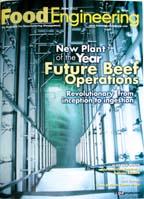
2002
Future Beef
Operations
Opened on August 9, 2001 in Arkansas City, KS, the new Future Beef Operations (FBO) LLC plant features several distinct businesses operating under one roof including fabrication and further processing operations, case-ready and ready-to-eat meats, a pet-treats firm and a tannery unlike any other. Driving some of these activities is a carcass dehairing process that represents the first commercially successful execution of this revolutionary beef-safety intervention. With a capacity for 1,725 head of cattle a day, Future Beef handles a fourth of the volume of the country’s largest slaughter facilities.
Blueprint for supply chain integration
The plant is also the fulcrum in a channel management strategy that is a blueprint for supply chain integration. True partnerships with a handful of customers replace spot-market selling of finished goods. Data capture systems yield detailed reports for ranchers and feed-lot operators on the quality of individual cattle. The ambitious goal: a quality-control feedback loop that will improve the genetic engineering of packing houses’ raw materials.
Six years of planning preceded the purchase and conversion of the Prairieland Processors plant from a 40,000-sq. ft. boxed beef facility to the 450,000-sq. ft., fully integrated finished-goods operation it is today. The new cattle holding area takes advantage of the natural slope of the 30-acre site, with the unloading dock at the low point. The stable measures 360 ft. long by 100 ft. wide and has the distinction of being America’s first fully enclosed holding area for cattle.
Depth of data capture unprecedented
Ear tags with electronic identity information on heads of cattle entering a packing house are not new, but the depth of data capture at FBO is unprecedented. As cattle move onto the kill line, the tag is scanned into an information system that tracks the carcass through evisceration and to the fabrication room. RF chips embedded in overhead conveyor trolleys allow the plant to accurately track the animal, even after it is split into two sides of beef. When the sides are graded, quality indicators such as degree of marbling and color are captured, along with a video image. Information is relayed back to FBO’s 1,200 primary farmers and 14 feedlot partners to give them guidance in improving the quality and consistency of future livestock. In effect, the plant closes the loop between cattle breeding and meat consumption.
Fecal contamination is the great challenge in beef processing. Waste is matted into the hair of the steers and cows coming through the kill line. While processors have devised multiple interventions to address the issue at various points in their production lines, cross contamination is virtually unavoidable.
Dehairing the animals before they are butchered remedies the problem, but previous attempts to do that had failed. Under the guidance of German scientist Rainer Dorstewitz, engineers installed a U-shaped series of cabinets where dehairing occurs. A solution of sodium sulfide is sprayed on the animals as they enter the Chad cabinets. The carcass is subjected to several high-pressure rinse cycles with water and a neutralizer before exiting the cabinets, hairless and essentially sanitary. As it moves through hide removal, there’s little chance that workers’ knives will be contaminated with E. coli from one animal and transferred to others. The problem of airborne hairs settling on carcasses and cross-contaminating them also is eliminated.

2003
American Italian Pasta Company
American Italian Pasta’s (AIPC) Tolleson, AZ, plant is the fifth plant built by the 15-year-old maker of dry pasta and noodles and it is consistent with the company’s focus on high volume, automated production. Site selection, project planning, equipment specification and project execution were all handled internally. AIPC’s engineering staff served as general contractor for the $47 million project. Quick completion was a priority. Even at 5 percent APR, a capital project of this scope costs almost $196,000 a month in financing alone. In a bold move to speed project completion, mechanics assembled two dryers weighing a combined 35 tons in adjacent warehouse space while the production area was being built, then lifted them into place with the aid of eight 10,000-lb. forklifts.
Brownfield looks brand spanking new
Though a brownfield project, the 285,500-sq. ft. facility has the fit and finish of a brand-spanking new plant. The original structure was built in 1978 by Borden Foods, which produced pasta there until 1998. More than 300 people generated 93 million pounds of unfinished goods then on nine lines. Under AIPC’s direction, fewer than 50 people will produce 109 million pounds on two lines.
The plant was designed with an eye toward tripling its current capacity. That’s not a long-term objective: the second short-goods line is scheduled to arrive this year. The production room can accommodate a fourth line, after which the warehouse will be converted. The mill next door already is scrambling to keep pace. Silos to store one million bushels of grain are under construction, but additional storage will be needed.
At other AIPC plants, cartoned goods are conveyed to a separate warehouse for palletizing, and the physical distance is an advantage. Conventional palletizers requiring little floor space are used in those facilities, but the Tolleson plant is landlocked. There wasn’t room for the 100 feet of accumulation conveyors needed. The solution was a robotic system. Engineers settled on three jointed-arm robots. The palletizers feed a Lantech stretch wrapper that can handle 83 pallets an hour. Wrapped pallets are then automatically conveyed to the warehouse.
Training a priority
Three mechanics were dispatched for two weeks of factory training to understand the robots and learn to troubleshoot. Off-site training is the exception at AIPC; more typically, suppliers send technicians to the plants to brief operators on their equipment, then make follow-up visits as needed. Workshops by AIB instructors on HACCP and food plant sanitation are also a training staple.
Workers skill levels go up as staffing numbers go down, and AIPC’s flat organizational chart puts a premium on operator expertise and initiative. To help imbue Arizona staffers with AIPC’s culture, workers were recruited from the Columbia, SC, and Excelsior, MO, plants. Certified trainers from throughout the organization also came to Arizona to train new recruits. When fully operational, four 12-hour shifts will run the plant 24/7, and veterans from other AIPC facilities will be seeded in all shifts to help guide the new employees.
Operators are management’s eyes and ears, and process improvements and cost-saving suggestions percolate up from them. The most promising ideas are implemented, with AIPC stock certificates going to the workers who suggest them. Once a year, a trip to Italy is awarded. This year’s winner was a packaging employee who conceived a system for dot-gluing cartons instead of sealing them with a strip of glue.


